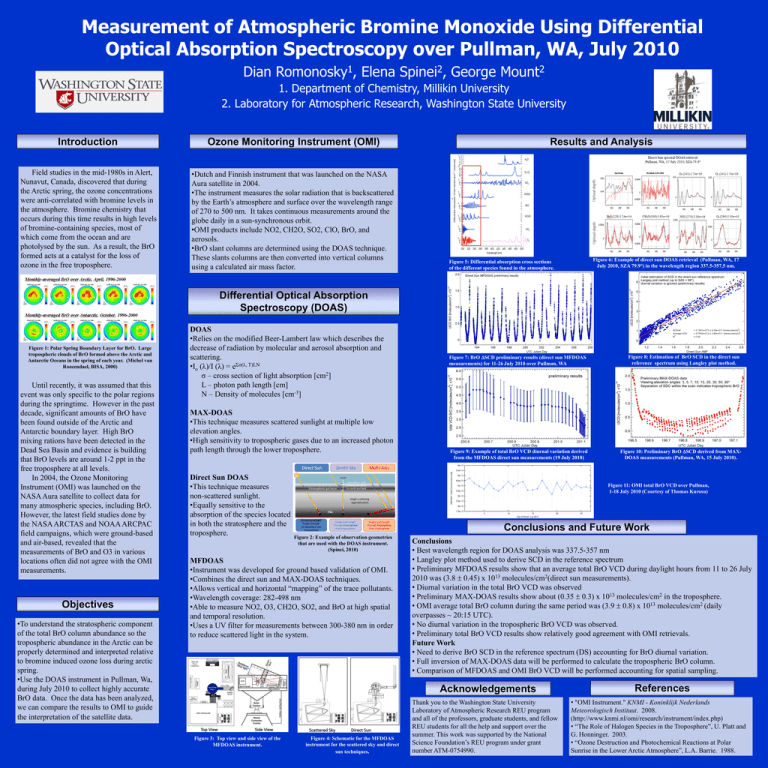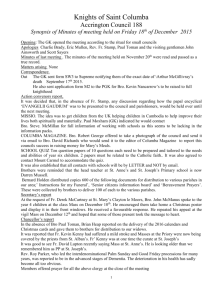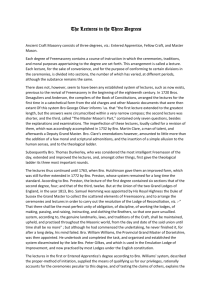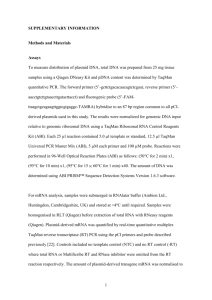Measurement of Atmospheric Bromine Monoxide Using Differential
advertisement

Measurement of Atmospheric Bromine Monoxide Using Differential Optical Absorption Spectroscopy over Pullman, WA, July 2010 Dian 1 Romonosky , Elena 2 Spinei , George 2 Mount 1. Department of Chemistry, Millikin University 2. Laboratory for Atmospheric Research, Washington State University Introduction Ozone Monitoring Instrument (OMI) Field studies in the mid-1980s in Alert, Nunavut, Canada, discovered that during the Arctic spring, the ozone concentrations were anti-correlated with bromine levels in the atmosphere. Bromine chemistry that occurs during this time results in high levels of bromine-containing species, most of which come from the ocean and are photolysed by the sun. As a result, the BrO formed acts at a catalyst for the loss of ozone in the free troposphere. •Dutch and Finnish instrument that was launched on the NASA Aura satellite in 2004. •The instrument measures the solar radiation that is backscattered by the Earth’s atmosphere and surface over the wavelength range of 270 to 500 nm. It takes continuous measurements around the globe daily in a sun-synchronous orbit. •OMI products include NO2, CH2O, SO2, ClO, BrO, and aerosols. •BrO slant columns are determined using the DOAS technique. These slants columns are then converted into vertical columns using a calculated air mass factor. Results and Analysis Figure 6: Example of direct sun DOAS retrieval (Pullman, WA, 17 July 2010, SZA 79.9°) in the wavelength region 337.5-357.5 nm. Figure 5: Differential absorption cross sections of the different species found in the atmosphere. Differential Optical Absorption Spectroscopy (DOAS) Figure 1: Polar Spring Boundary Layer for BrO. Large tropospheric clouds of BrO formed above the Arctic and Antarctic Oceans in the spring of each year. (Michel van Roozendael, BISA, 2000) Until recently, it was assumed that this event was only specific to the polar regions during the springtime. However in the past decade, significant amounts of BrO have been found outside of the Arctic and Antarctic boundary layer. High BrO mixing rations have been detected in the Dead Sea Basin and evidence is building that BrO levels are around 1-2 ppt in the free troposphere at all levels. In 2004, the Ozone Monitoring Instrument (OMI) was launched on the NASA Aura satellite to collect data for many atmospheric species, including BrO. However, the latest field studies done by the NASA ARCTAS and NOAA ARCPAC field campaigns, which were ground-based and air-based, revealed that the measurements of BrO and O3 in various locations often did not agree with the OMI measurements. Objectives •To understand the stratospheric component of the total BrO column abundance so the tropospheric abundance in the Arctic can be properly determined and interpreted relative to bromine induced ozone loss during arctic spring. •Use the DOAS instrument in Pullman, Wa, during July 2010 to collect highly accurate BrO data. Once the data has been analyzed, we can compare the results to OMI to guide the interpretation of the satellite data. DOAS •Relies on the modified Beer-Lambert law which describes the decrease of radiation by molecular and aerosol absorption and scattering. •Io (λ)/I (λ) = eƩσ(λ, T)LN σ – cross section of light absorption [cm2] L – photon path length [cm] N – Density of molecules [cm-3] MAX-DOAS •This technique measures scattered sunlight at multiple low elevation angles. •High sensitivity to tropospheric gases due to an increased photon path length through the lower troposphere. Direct Sun DOAS •This technique measures non-scattered sunlight. •Equally sensitive to the absorption of the species located in both the stratosphere and the troposphere. Figure 7: BrO SCD preliminary results (direct sun MFDOAS measurements) for 11-26 July 2010 over Pullman, WA Figure 9: Example of total BrO VCD diurnal variation derived from the MFDOAS direct sun measurements (19 July 2010) Figure 10: Preliminary BrO SCD derived from MAXDOAS measurements (Pullman, WA, 15 July 2010). Figure 11: OMI total BrO VCD over Pullman, 1-18 July 2010 (Courtesy of Thomas Kurosu) Conclusions and Future Work Figure 2: Example of observation geometries that are used with the DOAS instrument. (Spinei, 2010) MFDOAS •Instrument was developed for ground based validation of OMI. •Combines the direct sun and MAX-DOAS techniques. •Allows vertical and horizontal “mapping” of the trace pollutants. •Wavelength coverage: 282-498 nm •Able to measure NO2, O3, CH2O, SO2, and BrO at high spatial and temporal resolution. •Uses a UV filter for measurements between 300-380 nm in order to reduce scattered light in the system. Conclusions • Best wavelength region for DOAS analysis was 337.5-357 nm • Langley plot method used to derive SCD in the reference spectrum • Preliminary MFDOAS results show that an average total BrO VCD during daylight hours from 11 to 26 July 2010 was (3.8 0.45) x 1013 molecules/cm2(direct sun measurements). • Diurnal variation in the total BrO VCD was observed • Preliminary MAX-DOAS results show about (0.35 0.3) x 1013 molecules/cm2 in the troposphere. • OMI average total BrO column during the same period was (3.9 0.8) x 1013 molecules/cm2 (daily overpasses ~ 20:15 UTC). • No diurnal variation in the tropospheric BrO VCD was observed. • Preliminary total BrO VCD results show relatively good agreement with OMI retrievals. Future Work • Need to derive BrO SCD in the reference spectrum (DS) accounting for BrO diurnal variation. • Full inversion of MAX-DOAS data will be performed to calculate the tropospheric BrO column. • Comparison of MFDOAS and OMI BrO VCD will be performed accounting for spatial sampling. Acknowledgements Figure 3: Top view and side view of the MFDOAS instrument. Figure 8: Estimation of BrO SCD in the direct sun reference spectrum using Langley plot method. Figure 4: Schematic for the MFDOAS instrument for the scattered sky and direct sun techniques. Thank you to the Washington State University Laboratory of Atmospheric Research REU program and all of the professors, graduate students, and fellow REU students for all the help and support over the summer. This work was supported by the National Science Foundation’s REU program under grant number ATM-0754990. References • "OMI Instrument." KNMI - Koninklijk Nederlands Meteorologisch Instituut. 2008. (http://www.knmi.nl/omi/research/instrument/index.php) • “The Role of Halogen Species in the Troposphere”, U. Platt and G. Honninger. 2003. • “Ozone Destruction and Photochemical Reactions at Polar Sunrise in the Lower Arctic Atmosphere”, L.A. Barrie. 1988.




